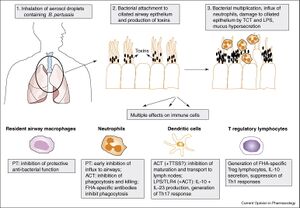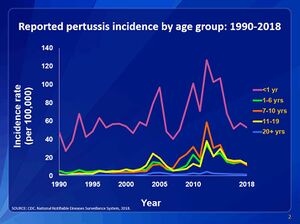Bordetella pertussis and the Importance of Vaccination: Difference between revisions
| Line 19: | Line 19: | ||
<br>Vaccination is a widely used practice to help prevent infectious disease and commonly spread illnesses. A widely known and common vaccine is used to prevent infection of Bordetella pertussis, the causative agent of Whooping cough. Whooping cough is known as one of the most common infectious disease deaths in the world<ref name=Kerr>[https://link.springer.com/article/10.1007/s100960050435/ Kerr, J.R. and Matthews, R.C."<i>Bordetella pertussis</i> Infection: Pathogenesis, Diagnosis, Management, and the Role of Protective Immunity." 2000. European Journal of Clinical Microbiology and Infectious Disease 19:77-88.]</ref>. The disease results in over 50 million cases worldwide per year, with the majority being unvaccinated individuals present in Third World Countries<ref name=Kerr></ref>. | <br>Vaccination is a widely used practice to help prevent infectious disease and commonly spread illnesses. A widely known and common vaccine is used to prevent infection of Bordetella pertussis, the causative agent of Whooping cough. Whooping cough is known as one of the most common infectious disease deaths in the world<ref name=Kerr>[https://link.springer.com/article/10.1007/s100960050435/ Kerr, J.R. and Matthews, R.C."<i>Bordetella pertussis</i> Infection: Pathogenesis, Diagnosis, Management, and the Role of Protective Immunity." 2000. European Journal of Clinical Microbiology and Infectious Disease 19:77-88.]</ref>. The disease results in over 50 million cases worldwide per year, with the majority being unvaccinated individuals present in Third World Countries<ref name=Kerr></ref>. | ||
B. pertussis is spread through coughing and sneezing and symptoms first appear seven to ten days after infection<ref name=WHO>[https://www.who.int/health-topics/pertussis#tab=tab_1/ World Health Organization: Pertussis 2018]</ref> | B. pertussis is spread through coughing and sneezing and symptoms first appear seven to ten days after infection<ref name=WHO>[https://www.who.int/health-topics/pertussis#tab=tab_1/ World Health Organization: Pertussis 2018]</ref>. These symptoms include: fever, runny nose, coughing which develops into a whooping cough, and phenomena<ref name=WHO></ref>. Those infected with pertussis are contagious for around three weeks once coughing is displayed as a symptom yet symptoms can last up to eight weeks<ref name=WHO></ref>. | ||
<br><br>A citation code consists of a hyperlinked reference within "ref" begin and end codes. | <br><br>A citation code consists of a hyperlinked reference within "ref" begin and end codes. | ||
Revision as of 19:12, 14 April 2022
Introduction and History

By Alexandra White
At right is a sample image insertion. It works for any image uploaded anywhere to MicrobeWiki.
The insertion code consists of:
Double brackets: [[
Filename: download.jpg
Thumbnail status: |thumb|
Pixel size: |300px|
Placement on page: |right|
Legend/credit:
Closed double brackets: ]]
Other examples:
Bold
Italic
Subscript: H2O
Superscript: Fe3+
Vaccination is a widely used practice to help prevent infectious disease and commonly spread illnesses. A widely known and common vaccine is used to prevent infection of Bordetella pertussis, the causative agent of Whooping cough. Whooping cough is known as one of the most common infectious disease deaths in the world[1]. The disease results in over 50 million cases worldwide per year, with the majority being unvaccinated individuals present in Third World Countries[1].
B. pertussis is spread through coughing and sneezing and symptoms first appear seven to ten days after infection[2]. These symptoms include: fever, runny nose, coughing which develops into a whooping cough, and phenomena[2]. Those infected with pertussis are contagious for around three weeks once coughing is displayed as a symptom yet symptoms can last up to eight weeks[2].
A citation code consists of a hyperlinked reference within "ref" begin and end codes.
To repeat the citation for other statements, the reference needs to have a names: "<ref name=aa>"
The repeated citation works like this, with a forward slash.[3]
Bordetella pertussis and Infection Stages
Include some current research, with at least one figure showing data.
Every point of information REQUIRES CITATION using the citation tool shown above.
Italic

B. Pertussis Vaccine History
Include some current research, with at least one figure showing data.
Italic
Vaccine Virulence
Include some current research, with at least one figure showing data.
Why Vaccination?

Conclusion
References
- ↑ 1.0 1.1 Kerr, J.R. and Matthews, R.C."Bordetella pertussis Infection: Pathogenesis, Diagnosis, Management, and the Role of Protective Immunity." 2000. European Journal of Clinical Microbiology and Infectious Disease 19:77-88.
- ↑ 2.0 2.1 2.2 World Health Organization: Pertussis 2018
- ↑ Cite error: Invalid
<ref>tag; no text was provided for refs namedaa
Authored for BIOL 238 Microbiology, taught by Joan Slonczewski, 2022, Kenyon College
